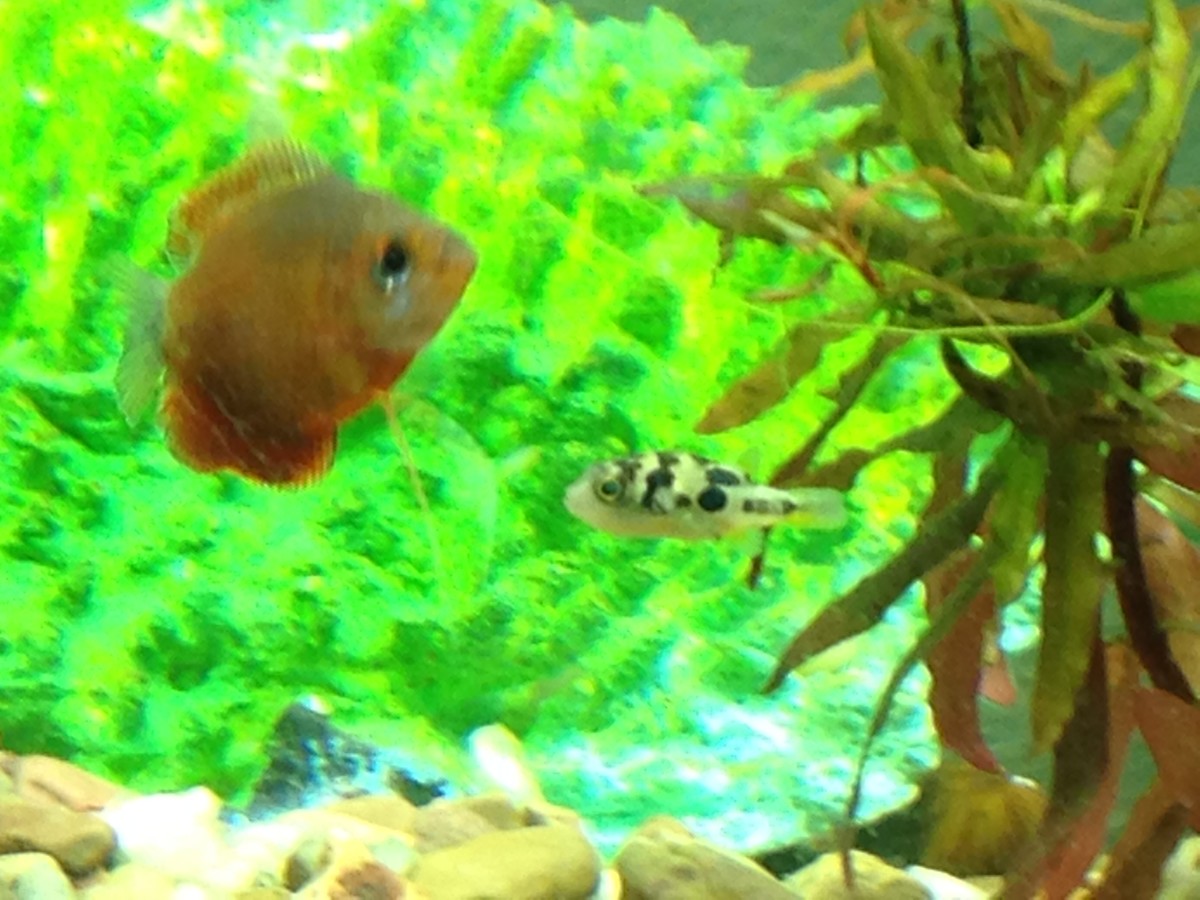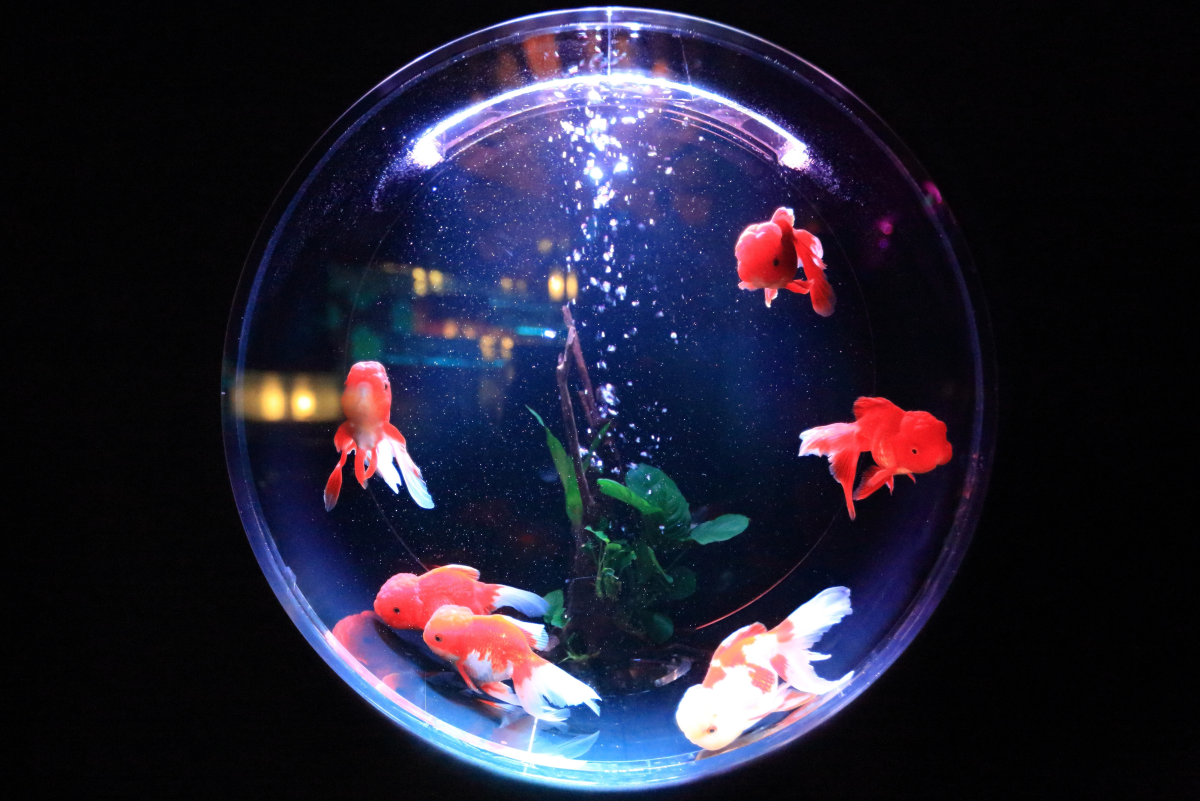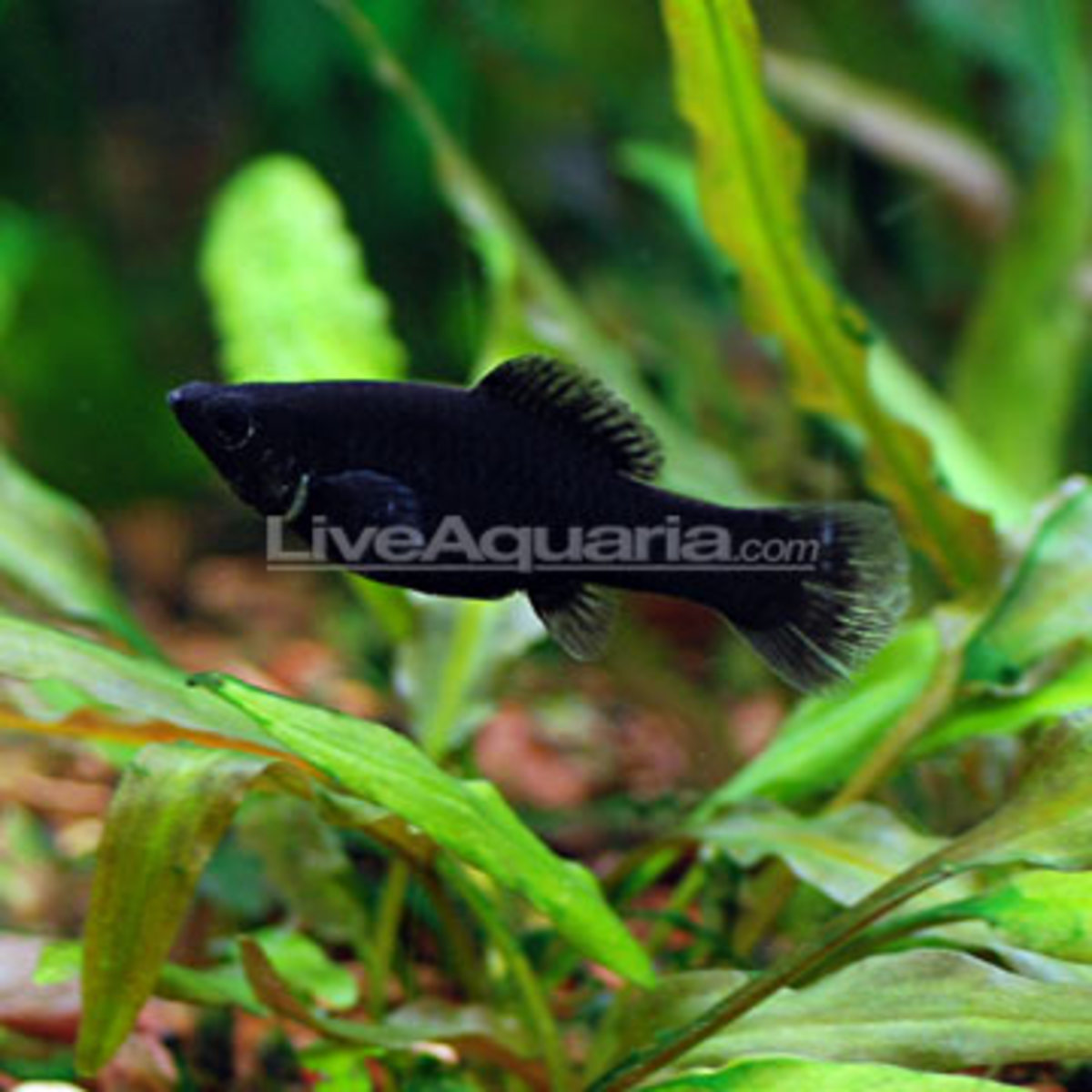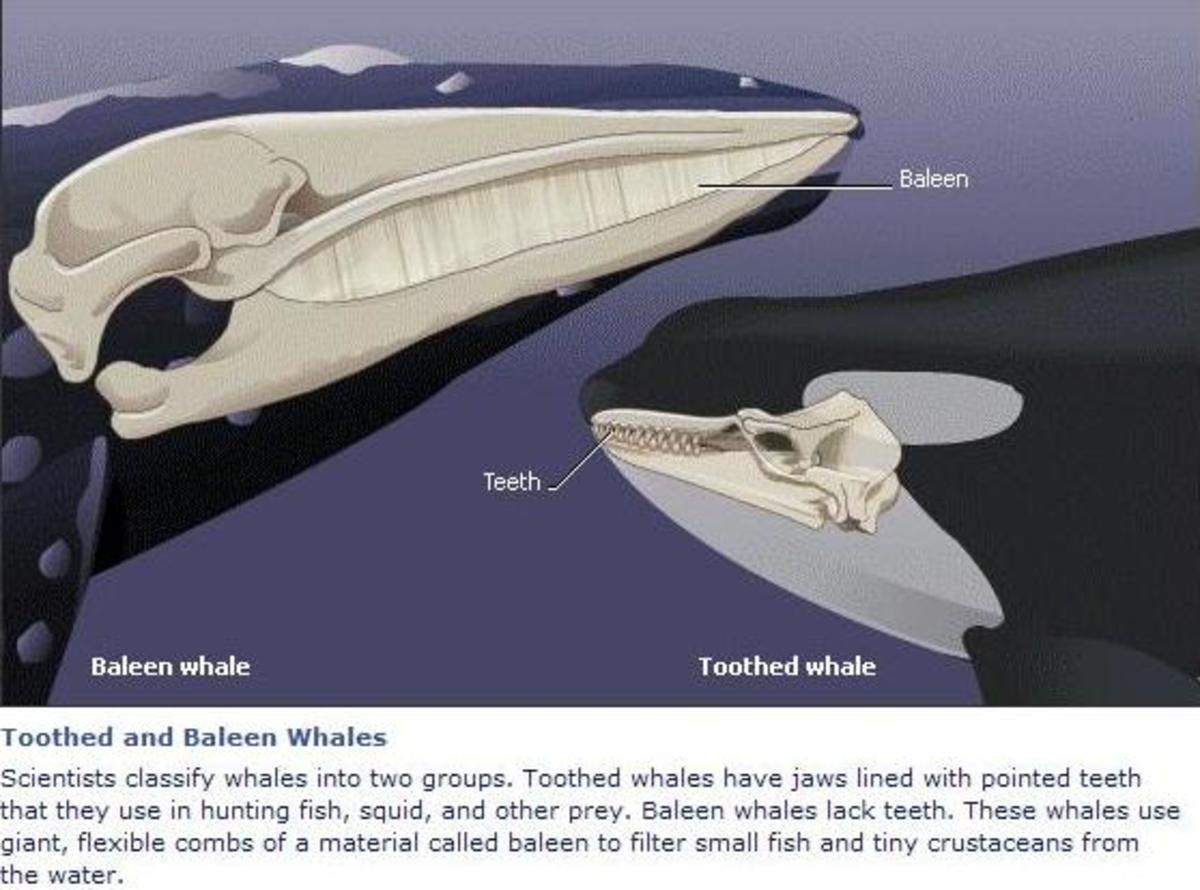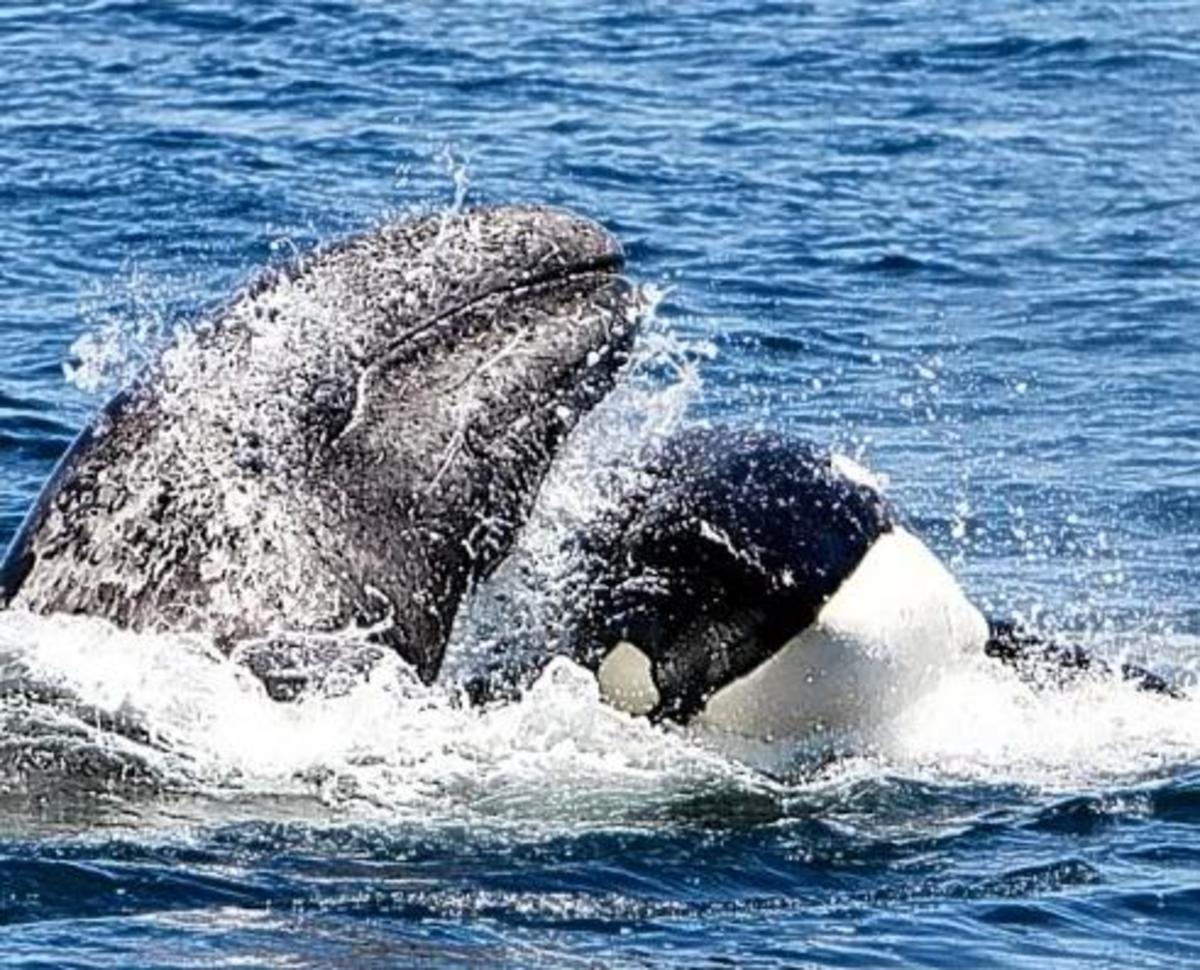- HubPages»
- Education and Science»
- Life Sciences»
- Marine Biology
Setting up a Saltwater Aquarium
What To Know About A New Salt Water Tank.
What To Know About A New Salt Water Tank.
The first setup to any fish tank is very crucial and can make the
different between a flourishing long-term aquarium and a catastrophe. There
are a lot of very significant things that need to be covered in assembling a tank:
1. Tank sizing
2. Substrate
3. Water supply Quality
4. Filtration
5. Fish Selection
6. Lighting
7. Upkeep
8. Safety
Tank Size
The most significant choice in your setup will comprise how large your tank is. Saltwater tanks deviate from other situations in that the bigger the tank you have, generally the easier it is to keep up, although costlier. The reasoning for this is that the greater the volume of H2O, the firmer the water quality is. If you accidently over feed or add too many chemicals, the tank can accept the "overdose" a little better.
For a starter, I'd suggest a tank in the range of thirty to ninety gallons. Any smaller than thirty gallons and it becomes hard to stabilize your H2O conditions.
Substrate
The substrate is what you put on the bed of your
tank, such as gravel in fresh tanks. Saltwater is extremely different
nevertheless.
In the past times, ground coral was viewed as the
finest choice for a substrate. Ground coral is just that. Coral pieces,
clam/snail shells, and so on crushed up into 1/2" to 1" pieces. The
welfare to this is that it is aragonite based, meaning that it is made
up of a calcium base. Calcium is very important in the softening of
your aquarium... it helps to maintain the pH scale of your H2O close to
8.2 . Now come the troubles with ground coral; the particles are rather
large and therefor have less surface area than such particles as sand.
This doesn't allow for bacteria to develop as bountiful, nor for such
animals as worms, amphipods, copepods and other advantageous animals to
develop and multiply in it. Why is this crucial you ask? These little
to microscopic animals are totally great sanitization agents. They work
as a filtrate in cleaning up left over food, decaying matter, and so
forth (see better details in Filtration) This all helps keep a heartier
tank.
The best substrate you can use is a fine aragonite sand.
At the local fish stores (LFS) you are able to find brand names such as
ESV, Aragamax, and CaribSea. These are altogether pretty decent
alternatives, but can be costly. For a less expensive path, check out
your nearest Home Depot. Look for Southdown Play Sand. It's a very
beneficial aragonite sand and bears fine particle size. It will cost
about $4 for 50lbs. as opposed to the stuff sold in the pet stores for
$30 for 30lb bagfuls! A assorted particle sandbed is better.
You
should add enough sand to get a 3-6" sand bottom. The deeper the
bottom, the better... however if you've a shallow tank, you might not
care to have too deep of a sandbed as it will bound the amount of room
in your tank. For tanks under 30 gals I propose a 3-4" sandbed. For
tanks over thirty gals I advise at least a 5" sandbed.
* 30 gallon tank with a 5" sand bed ~ 120lbs of sand
* 125 gallon tank with a 6" sand bed ~ 400lbs of sand
The
only other thing I can advise you do is to purchase a detrivore kit
(occasionally called live sand, sand activator, etcetera)
Finally,
there is a myth circulating in the fish tank hobby that you can use
ONLY aragonite (calcium grounded) sand and that silicate sand is bad
for your tank. This is exceedingly incorrect. Silicate based sand can
be applied in your saltwater tanks without having to care all but
phosphates being discharged. The sand will not have the buffering
capacities of calcium grounded sand, but it certainitly isn't required.
So if you like the way black sand looks... Plow ahead and use it, just
be sure there are no metals in it or inclement chemicals.... most
childrens fun sand is fine, just make certain to check the particly
size.
Aquarium Balancing Water Stabilizer
Reverse Osmosis Water Clarity
Water Quality
H2O quality is another big problem for a lot of saltwater aquariums. The H2O that comes out of our faucets is ordinarily mostly pretty horrifying. It is high in phosphates. Phosphates are what algaes live off of and if you've phosphates in your H2O, chances are you'll eventually get a high-risk outbreak of unwanted algae in your aquarium. A different thing to worry about, is copper. While copper in small amounts isn't damaging to fish, even small amounts will obliterate snails, shrimp, starfish and all other invertebraes. To see how bad the H2O coming out of your faucet is, check out this Water rating Site . If your phosphates and copper is not zero, you may be distressed (there are exclusions).
The next step of H2O quality is salinity. To make your fresh into seawater you'll need to purchase a bagful/bucket of synthetic ocean salt. I use Instant Ocean and it can be bought at Premium Aquatics , Marine Depot , and That Pet Place . To see a analysis of different makes of salt, check into this Salt Analysis . In order to acquire the correct level of salinity in your seawater, you'll require a hydrometer or a refractiometer. A refractiometer is much more exact, but also $75-100 compared to a $10 hydrometer. When you add your salt water, add it slow.... Approximately 1 cup every ten minutes. Stir the H2O while you add it and afterwards you add it, this will help the saltiness dissolve. If you've an fish tank heater setting about, put it in the H2O and attempt to have the temperature approximately eighty degrees. After each cup, use your hydrometer/refractiometer to measure the salinity level (salinity). Get it as close to 1.026 as you are able to. And then let the H2O sit for at least four hours before adding it to the tank. Afterwards adding it to the tank, make sure you tank temperature is around eighty-two degrees constantly every day.
The last part of dealing with H2O quality is H2O movement. A seawater fish tank needs to have water movement for the wellness of the fish likewise as for gaseous exchange so the H2O stays easily oxygenated. This is best done employing powerheads. A powerhead is a small submergible pump that sucks H2O in one end and spits it out the other. The better brand name I can suggest is MaxiJet. MaxiJet 1200s (MJ1200) is the best one to get. Also, don't buy RIO pumps! In the past few years they've been pretty shotty and several people have had them destroy their tanks. .
Water Quality Help
Among the best investments you are able to make in a seawater fish tank is purchasing an RO/DI water system filter. RO stands for reverse osmosis and DI stands for distilled. Most RO/DI filters are alike, they've 2-4 chambers and an adapter that screws onto your sink faucet. You then turn the sink water on luke warm (seventy-seven degrees) and the water runs through the filter, going out from two lines; the waste water line and the pure water line. The pure H2O breaks through very pure at 0ppm (parts per million) signifying that there are no chemicals, metals, etcetera in the water. This is the best H2O that you can use for ANY fish tank. One of the better brands of RO/DI filters can be purchased from AquaFX . The filters are also good for drinking H2O and cooking. Pasta and boiled vegetables will taste a great deal better applying cleaner H2O. Also, it makes crystal clear ice cubes!
Salt Water Aquarium
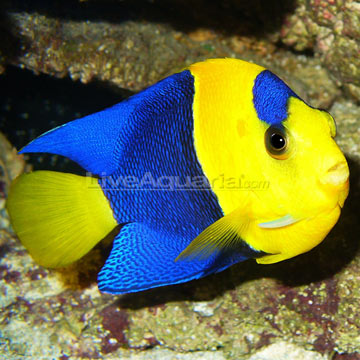
Fish Selection
The advice that I can afford you is no matter how beautiful or gracious a fish looks, if it's going to get bigger than eight" don't buy it. Only the biggest of the aquariums can keep fish this big happy and healthy. Unless your tank is 6 feet long you shouldn't buy a tang of any kind either. Also, no matter what you hear, a mandarin should be placed in aquariums no smaller than 55 gallons and only after the tank has been setup for over a year! They'll die of hunger otherwise.
Please make certain not to add too many fish to your tank either. For every 3 gals of H2O your fish tank bears, you should only have a maximum of 1" of fish. For example in a thirty gal fish tank you could have 3 3" fish. More than this and you'll begin to have trouble keeping your fish tank healthy
A great website to purchase fish from, as well as check compatibility is Live Aquaria .Com
Fluval Underwater Filtration
Filtration
Filtration is a very debateable issue. A lot of people have their own views on what is right and what is wrong. I'll assure you the views I've amassed from experience in addition a lot of reading.
The main filtration in your tank will arrive from your sandbed. It will hold in bacteria, worms, copepods, amphipods and several many critters to keep your tank clean. Their food is the equal to fish excretion. .
Other great source of filtration is called Live Rock. This is rock that's been collected from the sea and transported to you to be laid in your tank. It contains a lot of the pods, worms and bacterium as well and should be laid in all seawater fish tank. You should aim for 1/2-2 pounds of Live Rock per gal of fish tank. This won't only provide your tank with very demanded bacterium, but also protection for your fish to hide in and make them feel secure. This will keep them less stressed and therefor healthier.
You want to put the live rock in your tank prior to you add ANY fish. When live rock is sent, a few of the bacteria and other critters thereon die. When they go in your tank, they decay inducing what is named the ANN Cycle. ANN stands for Ammonia Nitrite Nitrate. As the deadened matter decomposes, the ammonia levels in the tank climb, then the nitrite. After a week or two these levels fall off and the nitrate level climbs. Almost any fish you put in the tank during this cycle WILL DIE. Don't put a fish into your fish tank for at least 3 weeks and buy a test kit to make certain your ammonia and nitrite levels are zero before buying a fish. A lot of fish shops will tell you to put a fish ... Likely a damsel, in your tank to "help" cycle the tank. This isn't necessary and will most likely result in the death of the fish. To help the cycle along, get to the market and buy a single raw cocktail shrimp. Add this to your tank. In two weeks, get rid of it. This will cycle your tank the same as the fish would, but you don't have to put the fish through the stress and most likely death of the cycle.
The seconday filtration for a seawater fish tank is a protein skimmer. A protein skimmer is a filter that produces air bubbles and removes waste from the water system by collecting foam. For tanks under fifty-five gallons I reccomend the PRIZM skimmer.
Some keynotes.... a UV filter shouldn't be employed in saltwater aquariums. They are occasionally used to kill "bad bacteria". However, they also kill all of the good bacterium, demolishing your natural filter.
Another popular myth from fish stores and unexperienced reefers is that a wet/dry or trickle filter is called for. This is untrue and will actually become a nitrate factory, trapping detritus and slowly having it decay befouling your water system. The only man made filter you need is a protein skimmer. (the ocassional use of a bagful of carbon is also reccomended to clean the water, but for no longer than 2 weeks at a time and replace the carbon after each use). Likewise NEVER place medications or ANYTHING containing copper in your tank.
High Output Lighting
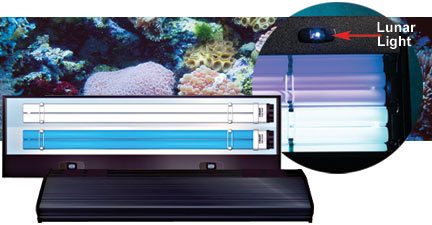
Aquarium Lighting!
Lighting
Lighting in a saltwater fish only aquarium is pretty easy. Most people employ flourescent lights. Nevertheless, if you want a very brightly lit tank that makes it much more aesthetic and easier to see the fish, look into buying PCs (power compacts) or VHO (Very High Output flourescents).
Whenver working with saltwater aquariums it's really important to think about your safety. The 1st matter you had better care about it electrocution. For this I recommend a GFCI (ground fault circuit interupter). What this does, is if the electric current from your power generator (such as a wall outlet) begins to go though something other than the wall outlet (such as yourself) it cuts the power. Although it is not a necesitty it could one day save your life. Please ask an electrician to install one for you.
A grounding probe is likewise a beneficial idea. It takes the stray electric potential that may be in your fish tank and routes it back to the electric outlet. This could also protect you from electrocution. It is cheap ($15) and you simply plug it in.
A Great Tank For Begginers And Pros Alike
Ive been doing this for a while, (5 years) and i can tell you one of the best things i have come across is the Aquapod 24 Gallon Nano Cube. This tank simplifies the hobby, and allows for an all in one, self contained design, to display a beautiful underwater habitat! Perfect for kids! If you set this puppy up correctly with adequate filtration and water movement, You will enjoy the comforts of of doing water changes 2 months apart instead of every 4 weeks! Its an amazing little Nano Reef life support! And a window into the wild blue! BEAUTIFUL!
If you still feel unsure and need some questions answered check out http://reefguards.com
For more education and information visit these links
- Reef Guards
Denver Aquarium Service







